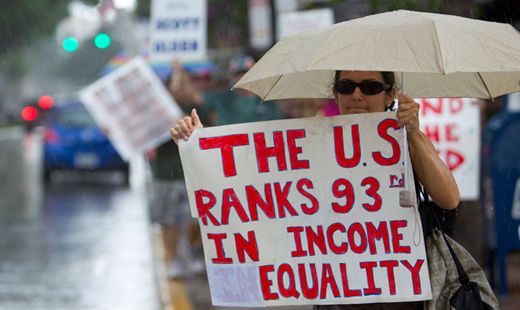
“If Silicon Valley were a country, it’d be sixth in the world in GDP per capita,” Russell Hancock at the 2015 State of Silicon Valley, Feb. 4, 2015
Columnist John D. Sutter of CNN Opinion visited Northern California’s Bay Area last year, resulting in “The Poor Kids of Silicon Valley,” an online interactive report on poverty, homelessness and income inequality in one of America’s wealthiest regions.
Subsequent coverage of the report highlighted stories such as that of young mother Nicole Jones, living in a garage in San Mateo County, paying $1000 a month and feeling lucky to have the space. After losing her job and her apartment, Jones and her baby girl took residence in the garage of an affluent neighborhood home in one of the wealthiest counties in the United States – unable, even with steady work, to afford the going price for a studio apartment, which can range from $1800-$2800 per month.
Also released this year was the 2015 Index from Joint Venture Silicon Valley, distributed at the yearly State of Silicon Valley conference in February.
This annual event gathers politicians, corporate leaders, and opinion-makers to reflect on the results of the report, presenting ideas for solutions that have gained popularity among industry circles, though tending to exclude some of the stakeholders with which it concerns itself, namely the working people of the Bay Area. It had at least one unmistakable conclusion in common with the CNN report though: Poor people aren’t doing very well in Silicon Valley, despite the vitality of the economy.
Hardest hit by income inequality are Blacks and Latinos, who are surviving on much less than the now recommended minimum of $84,000 per year for a family of four. Among the findings reported in the 2015 Index are:
* “There is a large gap between the highest and lowest earning racial/ethnic groups, which is larger in Silicon Valley ($44,037) and San Francisco ($50,069) than in California ($28,332) or the United States ($17,716).
* Men in Silicon Valley earn up to 61 percent more than their female peers. This gender-income gap is more pronounced in Silicon Valley than in San Francisco, California or the United States, and is getting larger over time.
* While poverty levels are relatively low, 29 percent of the region’s residents in 2012 were not self-sufficient (they did not make enough money to meet their basic needs without public assistance).”
One in 20 children lives on less than $2 a day in the United States. For the first time, 51 percent of school-age children in this country live in poverty. While the number of school-aged children on the free and reduced lunch program in Silicon Valley is below the state-wide level, it is still quite high. “37 percent of Silicon Valley public school students in 2012 and 2013 (and 38 percent in 2014) were receiving free or reduced price meals. In comparison, California’s percentage of students receiving free or reduced price meals increased by one percent to 59 percent in 2014, reaching a decade high.” (2015 Index)
Family income determines child poverty, and poverty in Silicon Valley hits Black and Latino children the hardest. “Per capita income increased in Silicon Valley (Santa Clara and San Mateo Counties) between 2011 and 2013 for all racial and ethnic groups, excluding Black or African American residents. White residents continued to have the highest per capita income ($64,998 in 2013, adjusted for inflation), and Hispanic or Latino residents continued to have the lowest ($20,961) and saw more modest income gains. The economic recovery that came swiftly for Silicon Valley after the Great Recession has not reached all residents here: “Per capita incomes for Black or African American and Hispanic or Latino residents in 2013 were still well below pre-recession values, down 20 and 12 percent, respectively since 2007.” (2015 Index)
Jorge Valencia lives in the other San Jose. One San Jose is home to famous internet and tech companies, with engineers who make six-figure salaries and live in homes with iron fences around them. The other San Jose is home to children who seldom have more than $2 a day for food. “Not five miles away from here, there are people basically just like swimming in gold,” said Valencia. “There’s like this invisible boundary around east side San Jose. They just don’t even see you as humans. They think you are trash, or peasants, or less.”
“The rent is too damn high.” – Jimmy McMillan
“In 2014, Silicon Valley rents were $645/month higher than California’s, and $1,198/month higher than average rents in the United States. Average rental rates in Silicon Valley continued the upward trend that began in 2010 (reaching $2,333/month in 2014), increasing by 8.7 percent ($171/month, amounting to $2,052 total) between 2012 and 2013. During the same time period, median income rose by 3.6 percent ($3,203 per year, or $267/month) in Silicon Valley.” (2015 Index)
Families which had managed rents of $1700 per month are now being displaced to other regions, as landlords raise rents to $2000 per month and above, citing the demand for housing by tech workers arriving to the region, who are willing to pay the higher rents.
Bay Area realtors and landlords, on the other hand, have increasingly pointed a finger of blame for rising rent prices on rent control, with some even calling for action to prevent rent stabilization ordinances. However, between San Francisco and San Jose, only one small Peninsula city has a rent stabilization ordinance, East Palo Alto. Therefore rent control cannot explain how rents in San Mateo County have soared along with their big-city counterparts.
“As the demand exists for lower-cost housing and is not met by the market then obviously the market is distorted and not ‘free,'” wrote local resident Mike Caggiano in a letter to the San Mateo Daily Journal, in response to claims that rising rent prices are caused by market forces.
Bizjournal reports, “State employment projections show that more than 50 percent of jobs added in Silicon Valley from 2008 to 2018 will pay less than $50,000 a year.” Clearly there is need for housing that costs less than $36,000 a year and above. “The median rental price in San Mateo County is $2975 per month – or a staggering $35,700 per year.” (CNN report)
“It takes five minimum wage jobs to afford a place to live here,” Jennifer Loving
Renting converted garages to live in is nothing new for underserved communities in Silicon Valley. Those unlucky enough not to find a garage to rent often live in cars while holding down jobs. Increasingly, white-collar professionals have joined the transient community, finding it cheaper to live in their cars close to work rather than pay exorbitant local rents or pay increased gas costs by commuting from over an hour away from work. Union employee Yaveth Gomez said, “I make $58,000 a year and it’s not enough to live and be able to eat here in San Jose. That’s why I live in my car.”
Car-living cuts across income levels, reported Kurt Varner, who lived in his car to save money while beginning a new life in Silicon Valley. “During my experience I saw many other people living from vehicles. It’s strange that most people are oblivious to it. There are even several other entrepreneurs I know that are taking to the streets to cut costs here in the Valley.”
One out of three young adults (18-34) in Silicon Valley lives with a parent.
San Jose, Oakland, and San Francisco have each passed ordinances raising their minimum wages, which is certainly a helpful piece in the process of putting more money into the hands of lower-income families. However, minimum wage in San Mateo County remains at the state level of $9/hour as apartment prices continue to rise to the highest in the nation. In 2014, an average renter would have needed to make $24/hr to afford a one-bedroom apartment in San Mateo County. Minimum wages of $10, $12 and even $15/hour won’t begin to scratch the surface of the rising living expenses in the Bay Area.
The median rent in the Silicon Valley city of Mountain View is $2700. It would cost “$269 million annually to produce a government-recommended 1,482 new affordable units for the very low-income in Santa Clara County alone, according to research by Housing Trust Silicon Valley.”
San Francisco’s median income is higher than other regions in the Bay Area at $75,604, with a 13.5 percent poverty rate. However, the median rental rate is $3200 per month, and several former fixed and low-income tenants have been forced out by landlords seeking to raise rents via “Ellis Act” evictions. Rent has doubled in three years.
“The decline in federal funding for housing is partly why cities like San Francisco are having such a tough time finding funding for affordable housing development and have to ‘tax’ new housing construction through inclusionary requirements and fees,” reports TechCrunch, citing cuts dating back to Reagan-era reduction in funds for public housing.
CNN’s Sutter suggests solutions for child poverty in his piece, including expanding federal housing subsidies, which would reduce child poverty in the U.S. by 20.8 percent, costing $23.5 billion dollars annually. That is much less than the current price of child poverty in the country, which is $500 billion annually. (CNN report)
The lack of political will for affordable housing solutions in the meantime has led to stress on cities surrounding Silicon Valley and San Francisco, especially in Oakland, across the Bay. The usually affordable and diverse city has seen an influx of renters from outside the city, fleeing rising rents in the Peninsula and South Bay, renters who are tolerant of higher rents than are the norm in Oakland. Oakland’s median income is $34,195. Oakland’s median rent has risen to $2,124 per month ($25,488/year).
“Over the last decade, thousands of Oakland residents have lost their homes to investors planning to primp, paint and flip them into more luxurious rentals. Some of those homes purchased for $135,000 now rent for $3,000 a month. For renters pushed out of San Francisco, this is a bargain, while many families who used to live in these homes have sought cheaper housing in far-flung suburbs,” said Susie Cagle in her report. “Oakland wants you to stop calling it the ‘Next Brooklyn.'” This trend has, in turn, reduced the historically Black city by 25 percent, of Black former residents.
In the face of rising inequity, solutions are being pursued in different areas of the region. SEIU 521 is leading the fight for a living wage for homecare workers in San Mateo County, opening the conversation in local media about the cost of living in the Peninsula that has led to discussion by the San Mateo Board of Supervisors about a living wage ordinance. County Manager John Maltbie has also brought the issue of rent stabilization to the Board.
In San Jose, the newly formed Silicon Valley Coalition, made up of unions and community partners, has affordable housing and living wages as their top goals.
Statewide, conversations are ongoing about Silicon Valley corporations offshoring billions in savings through tax loopholes, deriving the benefits of being located in a region rich in technological resources, but giving little back from the profits.
Photo: J. Pat Carter/AP









